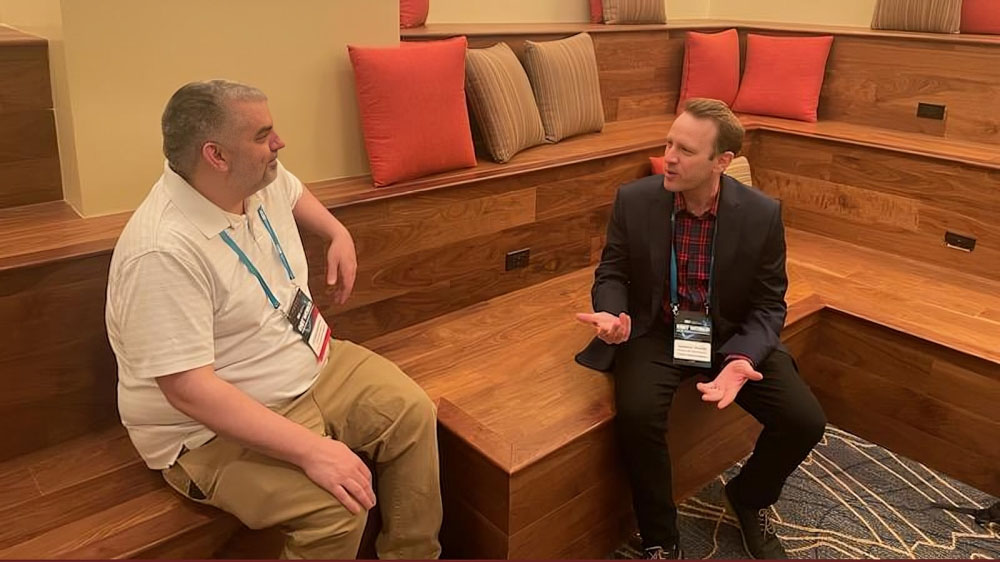ChannelPro SMB Forums are a reliably good vendue for meeting with some of the tech world’s top vendors, and last week’s kickoff event for 2022 in Newark, N.J., was no exception. Unsurprisingly, given the appetite most channel pros have for technician productivity at present, many of the exhibitors at that show emphasized integration, within their portfolios and with third-party vendors, during conversations with ChannelPro. Here are five specific integration-related sneak previews worth knowing about.
1. Axcient Pursues Integration with RMM and PSA Systems
Having completed the rollout of x360, its integrated availability suite for managed service providers, Axcient plans to train its efforts going forward on integrating more closely with leading distributors and other MSP tool makers.
“You’ll see an increase in APIs for us to integrate with other partners, like the Pax8s or potentially RMMs or PSAs,” says Charlie Tomeo, Axcient’s chief revenue officer.
Without citing specifics, Tomeo indicated that new reporting functionality aimed at verifying compliance with required data protection best practices for outside auditors is also on the way, and that securing x360 from unending threat activity will remain an ongoing priority.
“The bottom line is protecting your data,” Tomeo says. “All these other things are important, but if we don’t do that one thing, good luck.”
Axcient’s x360 suite includes BDR, file sync and share, and cloud-to-cloud backup components. A direct-to-cloud BDR product introduced in 2020 is currently outselling any other product the vendor has shipped in the last five years, according to Senior Vice President of Product Ben Nowacky in a conversation with ChannelPro earlier this month about the recent addition of backup verification functionality to that system. According to Tomeo, that system’s simplicity and affordability have weighed heavily on channel pros normally concerned about the performance and recovery speeds of direct-to-cloud BDR platforms.
“A lot of MSPs are struggling to make money with backup,” he says. “They’ll actually take a loss in some features and functionality if they can make 30% more margin.”
Matching those margins is difficult for competitors with deep investments in older, less efficient BDR technologies, Tomeo contends. “They just don’t have the flexibility now to reset everyone’s price to what the market should pay today,” he says. “Their infrastructure that they have built out is just a lot more expensive.”
2. Dark Cubed Looks to Deeper Firewall Integrations and Analytics
Dark Cubed, which offers automated threat detection and blocking technology, is focusing on “better quality integrations with some of the firewall manufacturers,” including WatchGuard, Sophos, and Check Point, during the first half of the year, according to Vince Crisler, founder and CEO of the Alexandria, Va.-based company.
“We starting to work with [WatchGuard’s] internal team and their partnership program so that we’ll have a lot more support for WatchGuard across the board,” he says. “As we go into the second half of this year, you’ll be seeing more features around moving beyond just the firewall, in terms of supporting some platform-as-a-service and infrastructure-as-a-service stuff, and also some endpoint integrations.”
Crisler adds that Dark Cubed will be developing more advanced analytics too. “We’re not trying to compete within the SIEM market, but giving MSPs more visibility across their customer base about trends and patterns.”
He concludes: “We’ve always been really focused on strong relationships in the channel and supporting our channel partners. … So for us, it’s just, how do we keep supporting the mission of these MSPs and doing it in a really simple, easy way, and helping them solve problems?”
3. Gradient MSP Looks to Be Channel Conduit
Startup Gradient MSP is seeing strong initial interest in Billable, the billing reconciliation solution for MSPs it rolled out in November, and its just-released Synthesize integration hub. Tim Coach, director of channel engagement at the Calgary, Alberta-based vendor, says that when Synthesize launched on February 14, “by the end of the day, we had 50 vendors that signed up to be a part of this program, because they realize that hooking into Gradient’s API and then having the MSP hook into it is better for both parties because the accuracy is there. You’re no longer uploading a CSV file. You’re taking that labor action out of it.”
Coach says Gradient MSP’s mission is to be “a conduit between the vendors and the MSPs to really work with each other better.”
While he would not reveal what was on the roadmap, he did say, “There’s several items coming down the road. … The focus of the company is to find the biggest pain points for the MSP and fix those.”
4. Kaseya is Finalizing Unified Interface for IT Complete Suite
Kaseya too has deeper integration on its near-term roadmap, only its efforts will focus more on synergies within its IT Complete product suite than on closer ties with third-party offerings.
The IT management vendor previewed the forthcoming introduction of single sign-on capabilities via Kaseya ONE, the centralized control plane for its collection of RMM, PSA, backup, and security solutions, at its ConnectIT partner conference last October. There’s even more integration to come this year, according to Amelia Paro, a channel development manager with Kaseya’s ID Agent unit.
“You’re going to see a lot more of that, so stay tuned,” she says. The resulting benefit for MSPs, she continues, will be less energy wasted on “the time between,” Kaseya’s term for the effort technicians who use multivendor toolsets rather than unified product suites spend switching among interfaces all day.
“Having some really slick integrations that are secure but workflow integrated is really going to reduce that time between and boost tech efficiency,” Paro says.
Hunger for that kind of efficiency, she continues, is driving increased demand among channel pros for unified toolsets like IT Complete as well as similar offerings from vendors such as ConnectWise, Datto, and N-able.
“Because of the way the market is changing, a lot of MSPs are looking to reduce the number of vendors they use,” she observes, adding that they also view the technician productivity made possible by integrated suites as a way to make coping with today’s air-tight IT labor market easier.
“Everybody’s having a hard time finding talent, but especially tech talent,” Paro notes.
5. Quickpass to Release an Open API, Launch Partner Program
Quickpass, a privileged access management company for MSPs that launched in 2019, has a flurry of rollouts coming in the next 12 months, starting with a partner program later in March, according to Jimmy Hatzell, who came on board as director of marketing in January. Hatzell says to expect integrations for the Datto Autotask and ConnectWise Manage PSA platforms soon as well.
The Vancouver, B.C., startup, which received $4 million in Series A financing from Arthur Ventures last October, has two products: QDesk, for end-user self-serve password resets, identity verification, and account management; and QGuard, for rotating privileged, service, and local account passwords from a password vault.
Within the first half of the year, Quickpass plans to release an open API that will allow MSPs to use the Quickpass password rotation toolkit for their own password managers. “There’s so many different password managers out there and so many different vaults, but to have the ability to be able to rotate passwords from privileged accounts and actually update it in those vaults, that’s going to be possible through our API,” Hatzell says.
Before year-end, Quickpass will release a zero-knowledge password vault, which means only the MSP controls the encryption keys. “It’s something very popular up market and is popular among MSPs as well, especially for homegrown solutions and homegrown password vaults. We see it as an important tool, and really what a lot of our customers are asking for. And our roadmap is completely driven by what our customers need.”














